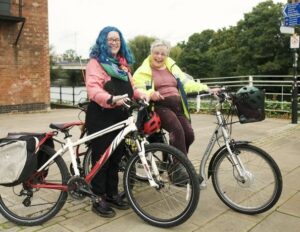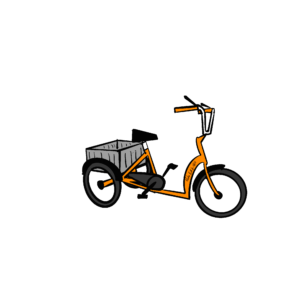For this episode of our My Cycle My Mobility Aid blog and podcast, we talked to Jean about her experience of seven decades of cycling.
Jean has been cycling since she was first given a tricycle at three years old. She now uses an e-assist tricycle to travel all around the area where she lives. Jean also uses a manual wheelchair and a powerchair, as well as a car, to meet all her transport needs.
Jean told us what cycling has meant for her at different stages of her life.

It all started when Jean took part in a film about children with cerebral palsy:
“when I was three years old, my parents and I took part in a social media film. And as part of that film, my mum and dad saw young children and adults with cerebral palsy playing and using tricycles for fun for exercise, for getting about- for living. And so they went off and decided to get me a tricycle.”
It wasn’t easy to find a school that would accept Jean with her mobility aid, but one local head understood the importance of both education and independent mobility:
“Most of the primary schools refused me, or my mum had to walk my tricycle to and from school every day, because I used my tricycle to get from home to school. But there was one school that did accept me, did allow me to ride my tricycle to school, said it would be kept under the window of the headmaster’s study, so that he and his secretary could keep an eye on it.”
Cycling is great physiotherapy for Jean:
“I’ve used, in the gym, a static bike, but it’s an upright, not a recumbent. My disability means that I find a recumbent position is antagonistic to the way my body wants to work.
I have tried to ride a bicycle, but I am much, much happier on a tricycle with three wheels. I went back to cycling as a result of advice from a neuro physio, someone specialising in the physiotherapy needs of a person with cerebral palsy. Cycling, because it’s a pattern, has a lot of advantages.”
And using a tricycle, rather than a static bike, makes her cycle a mobility aid as well as physiotherapy:
“I can go a lot further on a tricycle. If I walk- maybe 10 or 11 yards- if I cycle- five miles. So I’m on a tricycle. I live at the top of a hill and cycling back up hill when you’re tired, you do need the e-assist to help you pedal. Especially when you’ve got a weak left leg.
My cycling lets me reduce my car use so that if something’s happening within five miles of my home, usually just within my village, then I try and get there by trike rather than by car. Which means I get a little bit of exercise.”

Jean finds that cycling has advantages for leisure and socialising, too:
“I can do some photography from the trike and I’m quite stable while I’m doing that. And it would be impossible to be part of the community without the trike. We’ve lost the bus so I have no way of travelling with my neighbours now. I would have to travel independently in the car, it would be very insular. But being out on the trike, I can say hello to a neighbour. I can stop and have a discussion. And I can enjoy my community.”
Like many other Disabled people, Jean finds barriers on cycle routes a real problem:
“There is a policy that installs chicanes on all our cycling routes, and it is a nightmare.
On the direct route from my home to the city centre. within a mile, there are three chicanes that I have to get the trike through… And certainly when I’m coming home, trying to move from a standing start up hill from a chicane: Words fail me.
There are “no cycling” signs in all sorts of places.
Some experiences I’ve had really worry me. And if I wasn’t so bloody minded… I would have given up cycling more than once, which is not a good thing for my health.”
Jean knows what’s needed to improve accessibility:
“The accessibility is very much up to the attitudes of society, whether they see it as necessary, or not.
I really think there is an element of respect required that you don’t make life difficult for other people in trying to make life easier for yourself.”
Jean’s final points were around the advantages of buying her own tricycle two years ago:
“I could have continued to ride a hire bike from the Cycling Project. But I think I needed to buy my own so I had more opportunity to ride.
The costs of a tricycle, like the costs of anything for Disabled people was… slightly expensive. But it was a good purchase.
It’s been a good two years with a tricycle.”
You can listen to the full chat with Jean and the rest of our fortnightly My Cycle My Mobility Aid podcast series on our My Cycle My Mobility Aid podcast channel and download the transcript. We have campaigning resources and support available via our website at www.wheelsforwellbeing.org.uk , too
If you would like more information or to share your story for our campaign please contact Kate@wheelsforwellbeing.org.uk
